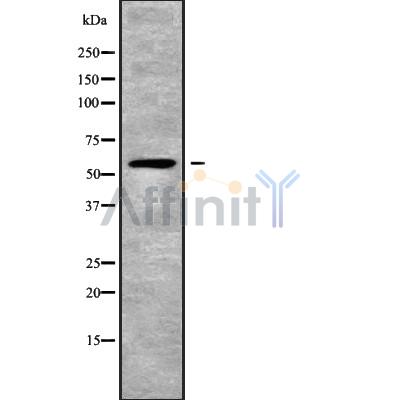CDC14B/C Antibody - #DF10121
| Product: | CDC14B/C Antibody |
| Catalog: | DF10121 |
| Description: | Rabbit polyclonal antibody to CDC14B/C |
| Application: | WB IHC |
| Reactivity: | Human, Mouse |
| Mol.Wt.: | 60 kDa; 57kD,52kD(Calculated). |
| Uniprot: | O60729 | A4D256 |
| RRID: | AB_2840701 |
Product Info
*The optimal dilutions should be determined by the end user. For optimal experimental results, antibody reuse is not recommended.
*Tips:
WB: For western blot detection of denatured protein samples. IHC: For immunohistochemical detection of paraffin sections (IHC-p) or frozen sections (IHC-f) of tissue samples. IF/ICC: For immunofluorescence detection of cell samples. ELISA(peptide): For ELISA detection of antigenic peptide.
Cite Format: Affinity Biosciences Cat# DF10121, RRID:AB_2840701.
Fold/Unfold
CC14B_HUMAN; Cdc 14B; Cdc 14B1; Cdc 14B2; CDC 14B3; CDC14 cell division cycle 14 homolog B; CDC14 homolog B; Cdc14b; Cdc14B1; Cdc14B2; CDC14B3; Cell division cycle 14 homolog B; Dual specificity protein phosphatase CDC14B; hCDC 14B; hCDC14B; OTTHUMP00000063774;
Immunogens
A synthesized peptide derived from human CDC14B/C, corresponding to a region within N-terminal amino acids.
- O60729 CC14B_HUMAN:
- Protein BLAST With
- NCBI/
- ExPASy/
- Uniprot
MKRKSERRSSWAAAPPCSRRCSSTSPGVKKIRSSTQQDPRRRDPQDDVYLDITDRLCFAILYSRPKSASNVHYFSIDNELEYENFYADFGPLNLAMVYRYCCKINKKLKSITMLRKKIVHFTGSDQRKQANAAFLVGCYMVIYLGRTPEEAYRILIFGETSYIPFRDAAYGSCNFYITLLDCFHAVKKAMQYGFLNFNSFNLDEYEHYEKAENGDLNWIIPDRFIAFCGPHSRARLESGYHQHSPETYIQYFKNHNVTTIIRLNKRMYDAKRFTDAGFDHHDLFFADGSTPTDAIVKEFLDICENAEGAIAVHCKAGLGRTGTLIACYIMKHYRMTAAETIAWVRICRPGSVIGPQQQFLVMKQTNLWLEGDYFRQKLKGQENGQHRAAFSKLLSGVDDISINGVENQDQQEPEPYSDDDEINGVTQGDRLRALKSRRQSKTNAIPLTVILQSSVQSCKTSEPNISGSAGITKRTTRSASRKSSVKSLSISRTKTVLR
- A4D256 CC14C_HUMAN:
- Protein BLAST With
- NCBI/
- ExPASy/
- Uniprot
MRSSTLQDPRRRDPQDDVYVDITDRLRFAILYSRPKSASNVHYFSIDNELEYENFSEDFGPLNLAMVYRYCCKINKKLKSITMLRKKIVHFTGSDQRKQANAAFLVGCYMVIYLGRTPEAAYRILIFGDTPYIPFRDAAYGSCNFYITLLDCFHAVKKAMQYGFLNFNSFNLDEYEHYEKAENGDLNWIIPDRFIAFCGPHSRARLESGYHQHSPETYIQYFKNHNVTTIIRLNKRMYDAKRFTDAGFDHHDLFFADGSTPTDAIVKRFLDICENAEGAIAVHCKAGLGRTGTLIACYIMKHYRMTAAETIAWVRICRPGLVIGPQQQFLVMKQTSLWLEGDYFRQRLKGQENGQHRAAFSKLLSGVDDISINGVENQDQQEPKPYSDDDEINGVTQGDRSRALKRRRQSKTNDILLPSPLAVLTFTLCSVVIWWIVCDYILPILLF
Research Backgrounds
Dual-specificity phosphatase involved in DNA damage response. Essential regulator of the G2 DNA damage checkpoint: following DNA damage, translocates to the nucleus and dephosphorylates FZR1/CDH1, a key activator of the anaphase promoting complex/cyclosome (APC/C). Dephosphorylates SIRT2 around early anaphase. Dephosphorylation of FZR1/CDH1 activates the APC/C, leading to the ubiquitination of PLK1, preventing entry into mitosis. Preferentially dephosphorylates proteins modified by proline-directed kinases.
Nucleus>Nucleolus. Nucleus>Nucleoplasm.
Note: Following DNA damage, translocates from the nucleolus to the nucleoplasm and interacts with FZR1/CDH1.
Composed of two structurally equivalent A and B domains that adopt a dual specificity protein phosphatase (DSP) fold.
Belongs to the protein-tyrosine phosphatase family. Non-receptor class CDC14 subfamily.
Dual-specificity phosphatase. Preferentially dephosphorylates proteins modified by proline-directed kinases (By similarity).
Endoplasmic reticulum membrane>Single-pass membrane protein.
Note: Retains its endoplasmic reticulum localization during mitosis.
Composed of two structurally equivalent A and B domains that adopt a dual specificity protein phosphatase (DSP) fold.
Belongs to the protein-tyrosine phosphatase family. Non-receptor class CDC14 subfamily.
Research Fields
· Cellular Processes > Cell growth and death > Cell cycle. (View pathway)
Restrictive clause
Affinity Biosciences tests all products strictly. Citations are provided as a resource for additional applications that have not been validated by Affinity Biosciences. Please choose the appropriate format for each application and consult Materials and Methods sections for additional details about the use of any product in these publications.
For Research Use Only.
Not for use in diagnostic or therapeutic procedures. Not for resale. Not for distribution without written consent. Affinity Biosciences will not be held responsible for patent infringement or other violations that may occur with the use of our products. Affinity Biosciences, Affinity Biosciences Logo and all other trademarks are the property of Affinity Biosciences LTD.

